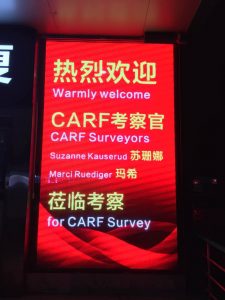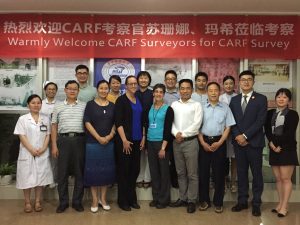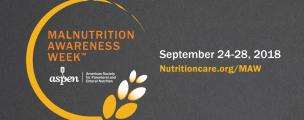Guest author: Marci Ruediger, PT, M.S., Director of Performance Excellence at Magee Rehabilitation Hospital
As a CARF (Commission on Accreditation of Rehabilitation Facilities) surveyor, I have the opportunity to travel throughout the United States and abroad, surveying medical rehabilitation hospitals and units for conformance to CARF standards. CARF™ International is an independent, accrediting body of health and human services, surveying and accrediting services such as rehabilitation for a disability, treatment for addiction and substance abuse, home and community services, and retirement living. CARF International has surveyed hundreds of thousands of programs throughout North and South America, Europe, Africa, and Asia since it was founded as an independent, nonprofit accreditor in 1966. My role is as a surveyor for medical rehabilitation, surveying inpatient and outpatient programs in spinal cord injury, brain injury, stroke, amputation, and general medical rehabilitation.
This summer I had the opportunity to travel to China and survey a program that was applying for accreditation for the first time. Since rehabilitation is relatively new in China, there are not many accredited rehabilitation programs. It is noteworthy that this was a private, for-profit hospital and not a government-run facility. We engaged frequently with the President who was passionate about bringing rehabilitation to more people in China.

A sign welcoming Marci and her fellow surveyor
When my co-surveyor and I arrived, we were surprised to be greeted as celebrities! Our names were posted on the electronic billboard outside of the hospital, and photographers took numerous pictures of us with the hospital team. They had already compiled and published a book about their journey to accreditation, complete with photos of key events, which they presented to us as gifts.
The three-day survey was a resounding success. We worked with interpreters who were familiar with the CARF standards in order to review documents and interview staff, administrators, patients, and referring agencies about the facility and the care that was provided to patients. Everyone was extremely friendly and very open to any ideas that we shared. As a physical therapist, I was particularly interested to observe the therapy and share ideas with my peers. Although therapists in the U.S. begin practice with doctoral degrees, therapists in China have considerably less formal education and learn a great deal while on the job. However, they are also knowledgeable about traditional Chinese medicine, and they integrate this with western techniques. It was really exciting to share ideas with these new colleagues.
One of the challenges staff face is that traditional Chinese medicine tends to be very passive. Patients are used to the provider doing the work, and they do not necessarily understand that they have to work to recover their function. Helping patients to be motivated to do hard work was sometimes a challenge. Some of the insights and skills that I shared with my therapy colleagues involved utilizing activity-based therapy to both motivate patients and help the neuromuscular system recover more fully.

Marci (center) with the rehab team in China
Perhaps the most fascinating aspect of the care we observed was how well families were integrated into the treatment and recovery plan. Patient rooms were very simple. They contained two beds (one for the patient and one for their family member), a small bin for clothing and personal items, and a small bathroom with a western toilet (as contrasted with the traditional squat toilet used widely in China). Food was brought to the floor in large pots at mealtimes, and family members brought out bowls to receive nutritious meals for the patients and themselves. Originally, families had been responsible to provide the food, but the hospital staff soon realized that nutrition, so critical to health and recovery, was often lacking, so they made the decision to supply the food as well as valuable information about preparing healthy meals.
Nurses care for many more patients than would be typical in a US hospital, so they rely heavily on families to provide most of the care. They begin teaching the families how to assist the patients from the moment they arrive. Families assist the patients to dress, toilet, bathe, eat, take their medications, and do their homework every evening. “Homework” is provided by each therapist and consists of exercises or activities that the patient is expected to do. Each family tracks what is done in a small notebook that is checked by the nurse each evening. In the morning, the team meets briefly to discuss progress, barriers, and any changes to the plan for each patient. By the time the patient is discharged, the family is very comfortable providing any care that is needed. This is really important because very little therapy is available once they leave rehabilitation.
After the survey was complete, I was fortunate to be able to spend another eight days traveling in China with two family members. We had a blast visiting historic sites, trying new foods, making new friends, and learning about the culture, history, and people. It was an amazing trip, capped off by a surprisingly arduous (and very hot) hike on the Great Wall (see our photo above). It was truly a world–wonder!
To learn more about Magee standards and accreditations, click here.







